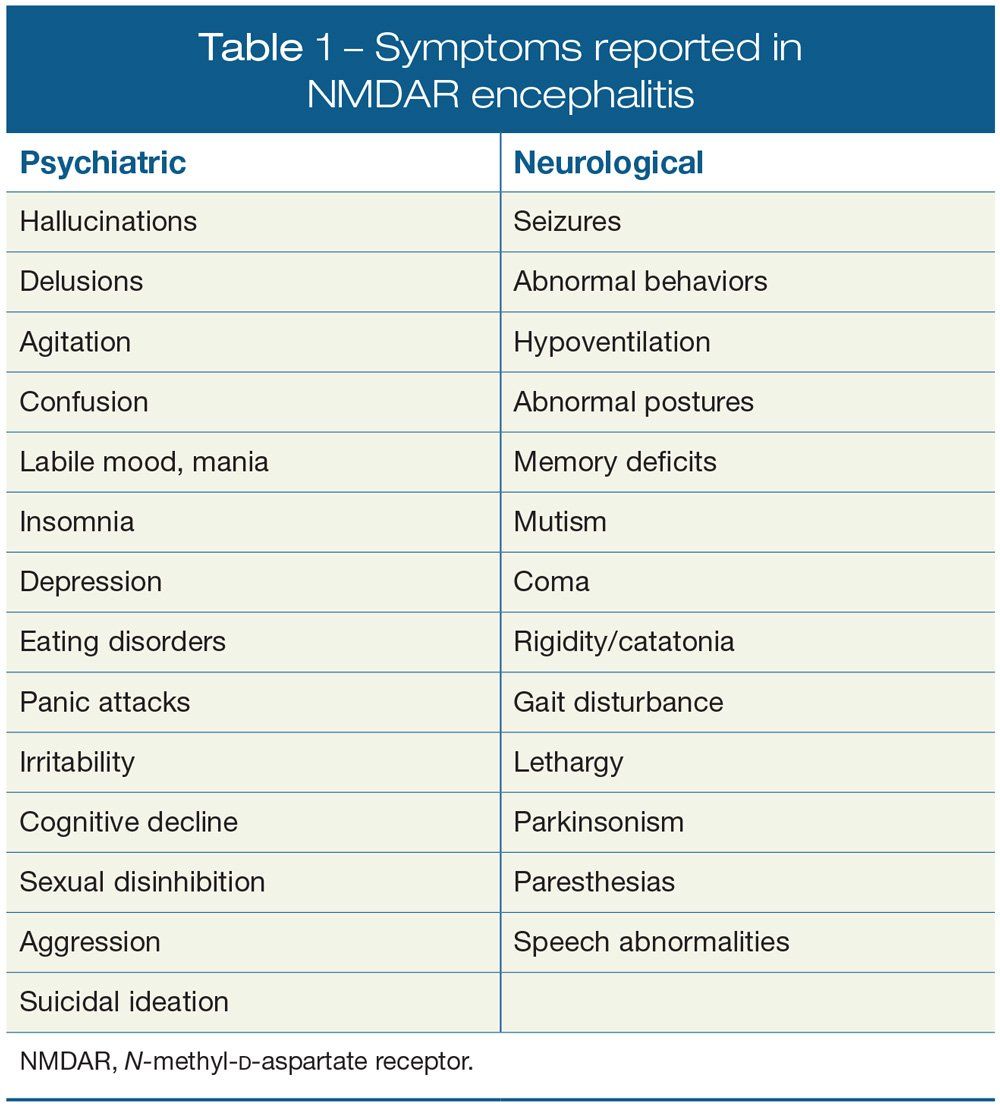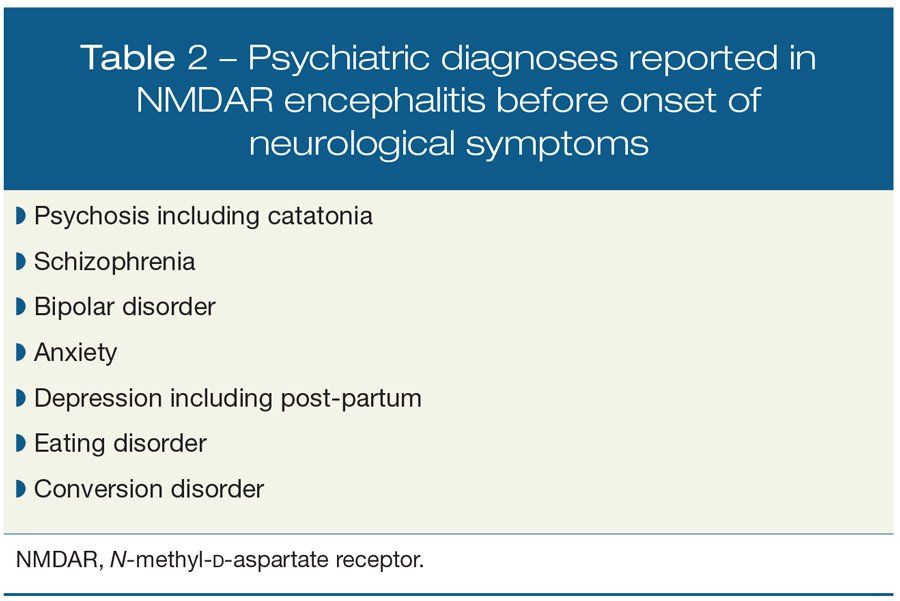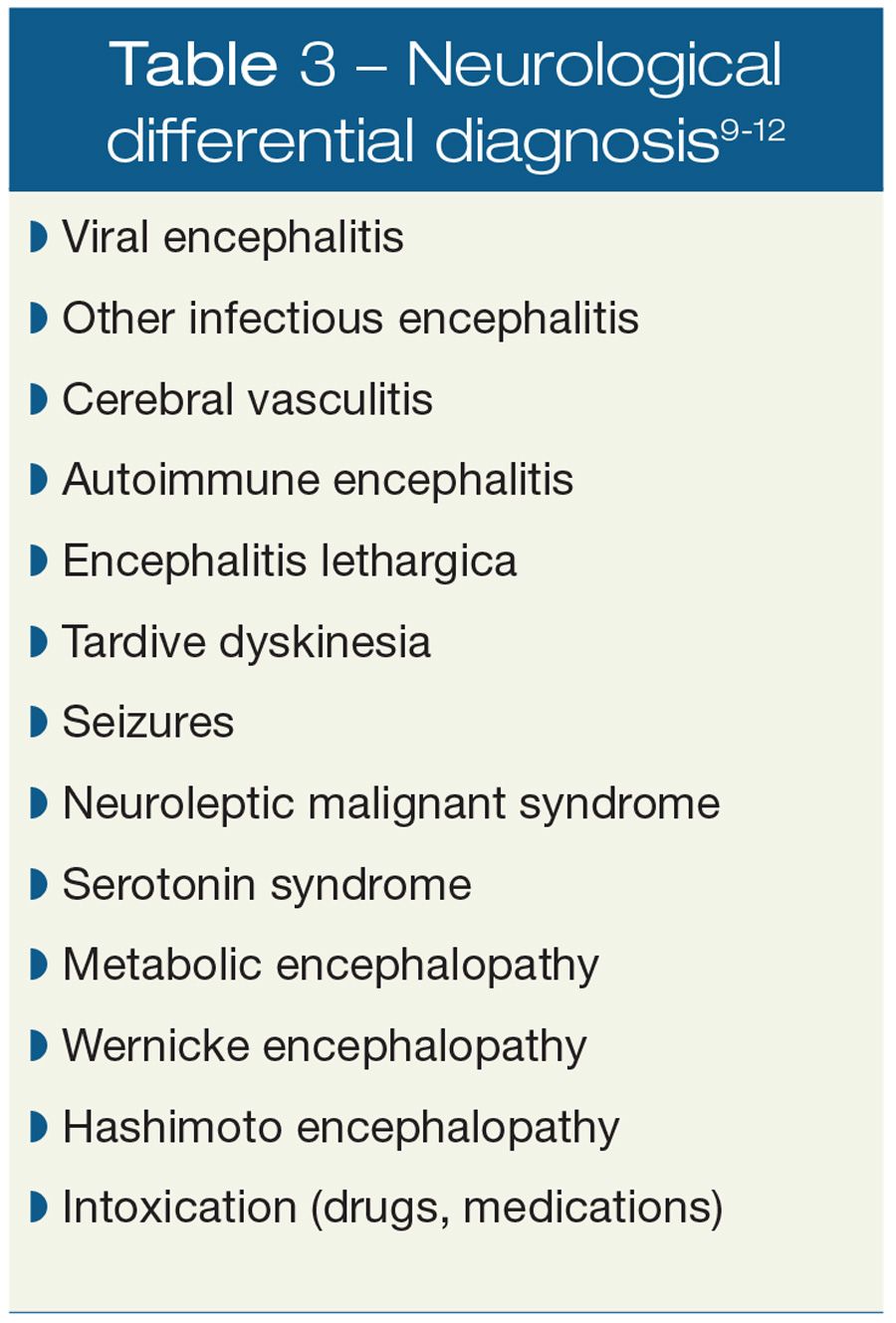Publication
Article
Psychiatric Times
Anti-NMDA Receptor Encephalitis: Diagnostic Issues for Psychiatrists
Author(s):
This articles focuses on the psychiatric and neurological implications of anti-NMDA receptor encephalitis.
Table 1 – Symptoms reported in NMDAR encephalitis

Table 2 – Psychiatric diagnoses reported in NMDAR encephalitis before onset of neurological symptoms

Table 3 – Neurological differential diagnosis[9-12]

Premiere Date: August 20, 2017
Expiration Date: February 20, 2019
This activity offers CE credits for:
1. Physicians (CME)
2. Other
All other clinicians either will receive a CME Attendance Certificate or may choose any of the types of CE credit being offered.
ACTIVITY GOAL
To identify the psychiatric and neurological implications of anti-NMDA receptor encephalitis.
LEARNING OBJECTIVES
At the end of this CE activity, participants should be able to:
• Recognize when a patient may be presenting with anti-NMDA receptor encephalitis
• Describe the progression of anti-NMDA receptor encephalitis symptoms
• Identify psychiatric and neurological signs and symptoms
• Describe the differential diagnosis for anti-NMDA receptor encephalitis symptoms
TARGET AUDIENCE
This continuing medical education activity is intended for psychiatrists, psychologists, primary care physicians, physician assistants, nurse practitioners, and other health care professionals who seek to improve their care for patients with mental health disorders.
CREDIT INFORMATION
CME Credit (Physicians): This activity has been planned and implemented in accordance with the Essential Areas and policies of the Accreditation Council for Continuing Medical Education (ACCME) through the joint providership of CME Outfitters, LLC, and Psychiatric Times. CME Outfitters, LLC, is accredited by the ACCME to provide continuing medical education for physicians.
CME Outfitters designates this enduring material for a maximum of 1.5 AMA PRA Category 1 Credit™. Physicians should claim only the credit commensurate with the extent of their participation in the activity.
Note to Nurse Practitioners and Physician Assistants: AANPCP and AAPA accept certificates of participation for educational activities certified for AMA PRA Category 1 Credit™.
DISCLOSURE DECLARATION
It is the policy of CME Outfitters, LLC, to ensure independence, balance, objectivity, and scientific rigor and integrity in all of their CME/CE activities. Faculty must disclose to the participants any relationships with commercial companies whose products or devices may be mentioned in faculty presentations, or with the commercial supporter of this CME/CE activity. CME Outfitters, LLC, has evaluated, identified, and attempted to resolve any potential conflicts of interest through a rigorous content validation procedure, use of evidence-based data/research, and a multidisciplinary peer-review process.
The following information is for participant information only. It is not assumed that these relationships will have a negative impact on the presentations.
James S. Brown Jr, MD, MPH, MS, has no disclosures to report.
Josep Dalmau, MD, PhD, (peer/content reviewer) reports that he has received a grant from the NIH; he receives royalties for NMDAR antibody testing and other autoimmune encephalitic testing products from Euroimmun.
Applicable Psychiatric Times staff and CME Outfitters staff have no disclosures to report.
UNLABELED USE DISCLOSURE
Faculty of this CME/CE activity may include discussion of products or devices that are not currently labeled for use by the FDA. The faculty have been informed of their responsibility to disclose to the audience if they will be discussing off-label or investigational uses (any uses not approved by the FDA) of products or devices. CME Outfitters, LLC, and the faculty do not endorse the use of any product outside of the FDA-labeled indications. Medical professionals should not utilize the procedures, products, or diagnosis techniques discussed during this activity without evaluation of their patient for contraindications or dangers of use.
Questions about this activity? Call us at 877.CME.PROS (877.263.7767)
The condition known as anti-N-methyl-D-aspartate receptor (NMDAR) encephalitis was first reported in 2005 but not identified as a diagnostic entity until 2007.1 At that time, 12 female patients were identified; they ranged in age from 14 to 44 years. All presented with various psychiatric and neurological symptoms, including personality and behavioral changes, paranoia, agitation, confusion, catatonia, autonomic instability, dyskinetic movements, seizures, hypoventilation requiring mechanical ventilation, hyperthermia (less often hypothermia), and coma.
All 12 patients had serum/cerebrospinal fluid (CSF) antibodies to the NR1 subunit of the NMDAR. Moreover, 11 had ovarian teratomas, of which 5 were examined and found to have nervous tissue expressing NR2 subunits that reacted with patient antibodies. The teratoma was removed in 8 patients, followed by immunotherapy that resulted in improvement of symptoms or full recovery. Two of three patients who did not have the tumor resected died.
Anti-NMDAR encephalitis is recognized as an autoimmune disorder in which IgG autoantibodies are directed against the NR1 subunit of the NMDAR. Binding of the antibodies to NMDARs induces internalization of the receptors in synapses, which is a mechanism that agrees with the glutamate hypothesis of schizophrenia in which NMDAR antagonists cause psychotic symptoms. The condition can present as a paraneoplastic syndrome that is often but not always associated with ovarian teratoma. However, in many patients no tumor can be found. A general definition of “paraneoplastic syndrome” is one that is caused by cancer but not by direct invasion so that most are the result of hormones, cytokines, and immune responses from or as a result of the tumor.2
Hundreds of cases of anti-NMDAR encephalitis have been reported, and many patients -possibly up to 40% -are initially hospitalized on psychiatric units.3 Some patients may present with psychiatric symptoms without neurological involvement, and there may not be any differences in demographics, psychiatric symptoms, or outcomes compared with patients who have neurological symptoms. In Dalmau’s original case series, 77% of cases were initially seen by psychiatrists and 23% by neurologists.4 Because of the significant morbidity and mortality associated with NMDAR encephalitis, it is essential that psychiatrists in all settings but especially in inpatient, emergency, and consultation-liaison roles be acquainted with the presentation and diagnosis of the condition.
Recognizing anti-NMDAR encephalitis
Most cases of anti-NMDAR encephalitis occur in young women, although ages range from 2 months to 85 years. Prodromal symptoms are common (more than 75% of patients) and usually appear as a viral syndrome with headache, fever, and respiratory and gastrointestinal symptoms. The initial psychiatric symptoms may include prominent visual and auditory hallucinations, paranoia, delusions, agitation, memory loss, depression, and eating disorders (Table 1).
The condition usually progresses to include serious neurological symptoms such as seizures, abnormal movements, autonomic instability, and hypoventilation. Seizures may include any type but especially generalized tonic-clonic or partial complex. Dyskinesias may be of any type but include orofacial, complex extremity, abdominal and pelvic movements, abnormal postures, and rigidity. A frequent pattern seen in case reports is admission to a psychiatric unit followed by transfer to an ICU after the onset of serious neurological symptoms. At this point, treatment usually requires a multidisciplinary approach.
Similar symptoms may be observed in children, although the youngest may have less apparent psychiatric symptoms and more prominent abnormalities of sleep, speech, and/or gait that progress to motor abnormalities, dyskinesias, and seizures. Tumors are found less often in pediatric cases. In older patients (older than 45 years), behavioral changes, seizures, and cognitive problems are frequent; males represent a greater proportion of cases than in younger groups; and fewer have an identifiable tumor compared with younger patients. Tumors, especially in older patients, can include not only ovarian tumors but also carcinomas and tumors of the breast, lung, and thymus as well as melanocytic nevi. In male cases, fewer tumors are found but have included schwannoma and mediastinal and testicular teratomas.
Misdiagnosis
Psychiatric misdiagnosis can occur before the onset of neurological symptoms. Early diagnoses have included schizophrenia, schizoaffective disorder, bipolar disorder, depression, conversion disorder, and anorexia nervosa (Table 2). However, most cases of schizophrenia, new-onset psychosis, and depression do not involve anti-NMDAR antibodies. Although most patients with anti-NMDAR encephalitis have no prior psychiatric histories, some do -including schizophrenia and autism, or positive family histories of mental illness. In cases of anti-NMDAR encephalitis in adults with preexisting autism or intellectual disability, initial presentations may be mistaken for new-onset primary psychosis or medication effects.
One case report describes a young woman with a 7-year history of schizophrenia who received a diagnosis of anti-NMDAR encephalitis, although the relationship of her prior schizophrenia to the newly diagnosed encephalitis could not be discerned.5 In another case report, a young woman with a 14-year history of neuropsychiatric symptoms presented as an outpatient with symptoms of word-finding difficulties, later diagnosed as anti-NMDAR encephalitis.6
Anti-NMDAR encephalitis can occur during pregnancy and can resemble postpartum depression and neuroleptic malignant syndrome (NMS). Many symptoms of NMS (rigidity, hyperthermia, elevated serum creatine kinase, rhabdomyolysis) may also occur in anti-NMDAR encephalitis. Testing for anti-NMDAR antibodies should therefore be considered in any patient with acute-onset psychiatric symptoms who has neurological or autonomic abnormalities, including rigidity and altered consciousness. (See Sansing and colleagues7 for an in-depth discussion of differential diagnoses for anti-NMDAR encephalitis, NMS, and serotonin syndromes.)
Presenting symptoms
Psychiatrically and neurologically, the differential diagnosis is quite broad (Table 2 and Table 3). A key factor for recognizing this disorder is that it often follows a pattern of syndrome development. In about 70% of cases, prodromal symptoms develop, including headache, fever, and gastrointestinal and upper respiratory tract symptoms. Usually within 2 weeks, psychiatric symptoms emerge, which often leads to psychiatric assessment. These symptoms may include anxiety, insomnia, delusions, mania and paranoia, possibly social withdrawal, and stereotypical behaviors. Short-term memory loss occurs as does disrupted language.
The condition progresses to decreased responsiveness with agitation, catatonia, abnormal movements, and autonomic instability and “storms,” as well as hypoventilation that may require ventilation. Seizures including status epilepticus can occur at any stage, can overlap with abnormal movements, and can decrease over the course of the illness.
The diagnosis is often made on the presence of neurological impairment, including abnormal movements, speech problems, rigidity, and altered consciousness as indications of something other than primary psychiatric disorders, although these are not universal. Drug screening and medication history may help rule out intoxication. Encephalitis from other causes including infections and autoimmune responses can be assessed with basic laboratory screenings, metabolic testing, immunological testing, MRI findings, and response to treatments such as thiamine and corticosteroids. Once anti- NMDAR encephalitis is diagnosed, care of the patient usually involves psychiatric consultation on ICU, surgery, medical, and/or neurological units.
Very small and even microscopic tumors can cause anti-NMDAR encephalitis, and the condition can occur as a complication of herpes simplex encephalitis. Initial laboratory studies can be normal, electroencephalograms (EEGs) can show non-specific slowing, and CSF analysis may show only lymphocytic pleocytosis. Confirmation of the diagnosis is based on positivity of the serum or, more importantly, the CSF for antibodies to the GluN1 NMDA receptor subunit. Serum testing alone may result in false positive or negative results.
Treatment
Following tumor resection, if a tumor is found, treatment often begins with first-line immunotherapy (corticosteroids, plasma exchange, intravenous immunoglobulin). Second-line immunotherapy (rituximab, cyclophosphamide) may become necessary and increases the likelihood of better outcome.
Psychiatric management includes psychotropic medications, although the response can be poor especially before a precise diagnosis is made. Irritability toward caregivers and family is often reported, and suicidal ideation with severe agitation and aggression can occur. ECT has been used successfully in some cases of catatonia but is not well studied and not always successful. Some treatment recommendations include atypical antipsychotics for behavioral symptoms, valproic acid for mood dysregulation, and benzodiazepines for catatonia. Medically induced comas have sometimes been required in the most psychiatrically severe cases.
Recovery depends on many factors, but Dalmau’s original case series remains a general guide: 75% of patients recovered, although some still had mild residual deficits, and 25% had poor outcomes with severe residual deficits or died. Because anti-NMDAR encephalitis is potentially curable, early diagnosis and treatment including tumor removal and immunotherapy are key to best outcomes. Antipsychotic medications can help control psychotic symptoms; however, be aware that, especially before diagnosis, rigidity and autonomic instability from anti-NMDAR encephalitis can be mistaken for NMS, and antipsychotic medications can cause NMS in these patients.
Improvement of psychiatric and neurological symptoms during treatment can be observed within days -in some cases hours -after tumor resection, but full recovery may be a slow process, perhaps taking several months, with possible relapses. Most neurological symptoms may improve, but executive functions and severe psychiatric symptoms, including suicidality and aggression, can persist for many months, possibly requiring inpatient psychiatric treatment. Lengthy outpatient psychiatric treatment with antipsychotic medication may be necessary. Recurrences caused by recurring tumors have also been reported.
Much remains to be learned about the various presentations of anti- NMDAR encephalitis. A case report, for example, described an adolescent who presented to an outpatient service and received a diagnosis of atypical anorexia nervosa without secondary amenorrhea.8 She was treated as an outpatient until 3 weeks later when she was admitted with a seizure. On day 23 of hospitalization, hallucinations developed that did not respond to antipsychotic medications. They were initially diagnosed as dissociative because the neurological workup was mostly non-specific. The diagnosis of anti- NMDAR encephalitis was confirmed 36 days after admission.
No tumor was found, but near-baseline functioning was achieved with immunotherapy after 10 months. The case is atypical because most patients with anti-NMDAR encephalitis do not have an identifiable eating disorder.
Conclusion
Future research on anti-NMDAR encephalitis will contribute to our knowledge of psychosis, autoimmunity, and glutamatergic function; although the extent to which the condition applies to specific conditions such as schizophrenia remains unknown. However, the recognition of anti-NMDAR encephalitis has already led to further research that contributed to the discovery of other autoimmune synaptic encephalitides. And, the elucidation of anti-NMDAR encephalitis has led to new approaches to the diagnosis of catatonia, movement abnormalities, memory problems, seizures, and limbic encephalitis.
CASE VIGNETTE
Jenny, a 23-year-old white graduate student with no psychiatric history, has had a flu-like condition with headache and nausea for about 10 days, and she has been having problems in school because of unusual memory loss. At home, she seems lethargic during the day but is unable to sleep at night. Her family reports that Jenny has become irritable, which is out of character for her. They brought her to the ED after she was found wandering confused in the yard.
An uncle has bipolar disorder, and the family is concerned she may have the same condition. She has a temperature of 100ºF, but baseline blood work and physical and neurological examination results are normal. A brain CT scan is unremarkable. Psychiatric assessment finds symptoms consistent with mild depression, but she is alert and oriented. There are no findings that support admission. Antibiotics are prescribed, and the patient is discharged.
A few days later she returns to the ED after becoming agitated and paranoid and experiencing auditory hallucinations. She is admitted to the psychiatric unit, where she exhibits bizarre behavior including giggling, echolalia, and posturing. She has frequent cycling leg movements and believes that staff members are plotting against her and that her food is poisoned. She is hyperkinetic, screaming, hallucinating, and sexually disinhibited. Antipsychotic medications do not seem effective, and prominent orofacial dyskinetic movements develop.
She experiences altered mental status followed by a generalized tonic-clonic seizure, although she has no history of seizures. An EEG shows nonspecific slowing, and leukocytosis is noted in the CSF. She does not return to her previous level of consciousness, autonomic instability develops, and she is transferred to the ICU.
In the ICU she requires sedation and mechanical ventilation. Subsequent EEGs reveal only nonspecific slowing, and a brain MRI scan shows non-specific small hyperintensities. During an extensive work-up, anti-NMDA receptor antibodies are found in her CSF. CT scanning of the chest, abdomen, and pelvis reveals a small right ovarian mass. The tumor is surgically resected and diagnosed as a teratoma.
Three days after the operation, she starts to improve significantly and is extubated. She receives first-line immunotherapy before discharge to a rehabilitation unit. Several months later, her neurological and psychiatric examinations are normal and she returns to academic study.
CME POST-TEST
Post-tests, credit request forms, and activity evaluations must be completed online at www.cmeoutfitters.com/PT (requires free account activation), and participants can print their certificate or statement of credit immediately (80% pass rate required). This Web site supports all browsers except Internet Explorer for Mac. For complete technical requirements and privacy policy, visit www.neurosciencecme.com/technical.asp.
Disclosures:
Assistant Clinical (Adjunct) Professor of Psychiatry, VCU [Virginia Commonwealth University] School of Medicine, Department of Psychiatry, Richmond, VA
References:
1. Dalmau J, Tuzun E, Wu HY, et al. Paraneoplastic anti-N-methyl-D-aspartate receptor encephalitis associated with ovarian teratoma. Ann Neurol. 2007;61:25-36.
2. Darnell RB, Posner JB. Paraneoplastic Syndromes. Oxford, UK: Oxford University Press; 2011.
3. Lejuste F, Thomas L, Picard G, et al. Neuroleptic intolerance in patients with anti-NMDAR encephalitis. Neurol Neuroimmunol Neuroinflamm. 2016;3:e280.
4. Dalmau J, Gleichman AJ, Hughes EG, et al. Anti-NMDA-receptor encephalitis: case series and analysis of the effects of antibodies. Lancet Neurol. 2008;7:1091-1098.
5. Chen SL, Lee SY, Chang YH, et al. Inflammation in patients with schizophrenia: the therapeutic benefits of risperidone plus add-on dextromethorphan. J Neuroim Pharmacol. 2012;7:656-664.
6. Heekin RD, Catalano MC, Frontera AT, Catalano G. Anti-NMDA receptor encephalitis in a patient with previous psychosis and neurological abnormalities: a diagnostic challenge. Case Rep Psychiatry. 2015;2015:253891.
7. Sansing LH, Tuzun E, Ko MW, et al. A patient with encephalitis associated with NMDA receptor antibodies. Nature Clin Pract Neurol. 2007;3:291-296.
8. Mechelhoff D, van Noort BM, Weschke B, et al. Anti-NMDA receptor encephalitis presenting as atypical anorexia nervosa: an adolescent case report. Eur Child Adolesc Psychiatry. 2015;24:1321-1324.
9. Florance NR, Davis RL, Lam C, et al. Anti-N-methyl-D-aspartate receptor (NMDAR) encephalitis in children and adolescents. Ann Neurol. 2009;66:11-18.
10. Barry H, Byrne S, Barrett E, et al. Anti-N-methyl-D-aspartate receptor encephalitis: review of clinical presentation, diagnosis, and treatment. BJPsych Bull. 2015;39:19-23.
11. Suhs KW, Wegner F, Skripuletz T, et al. Heterogeneity of clinical features and corresponding antibodies in seven patients with anti-NMDA receptor encephalitis. Exper Ther Med. 2015;10:1283-1292.
12. Maccaferri GE, Rossetti AO, Dalmau J, Berney A. Anti-N-methyl-D-aspartate receptor encephalitis: a new challenging entity for consultation-liaison psychiatrists. Brain Disord Ther. 2016;5:215.






